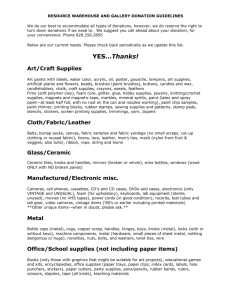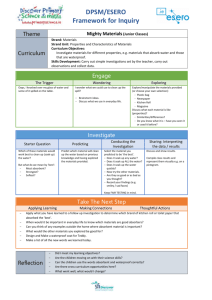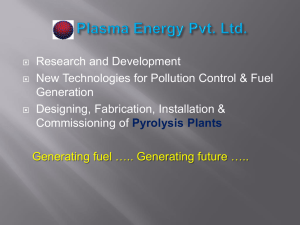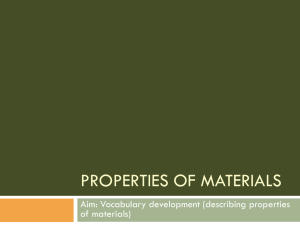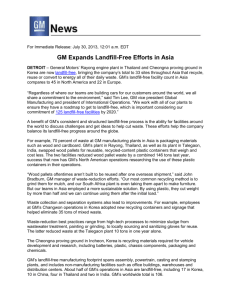Grade 2 Chapter 3 Materials
advertisement
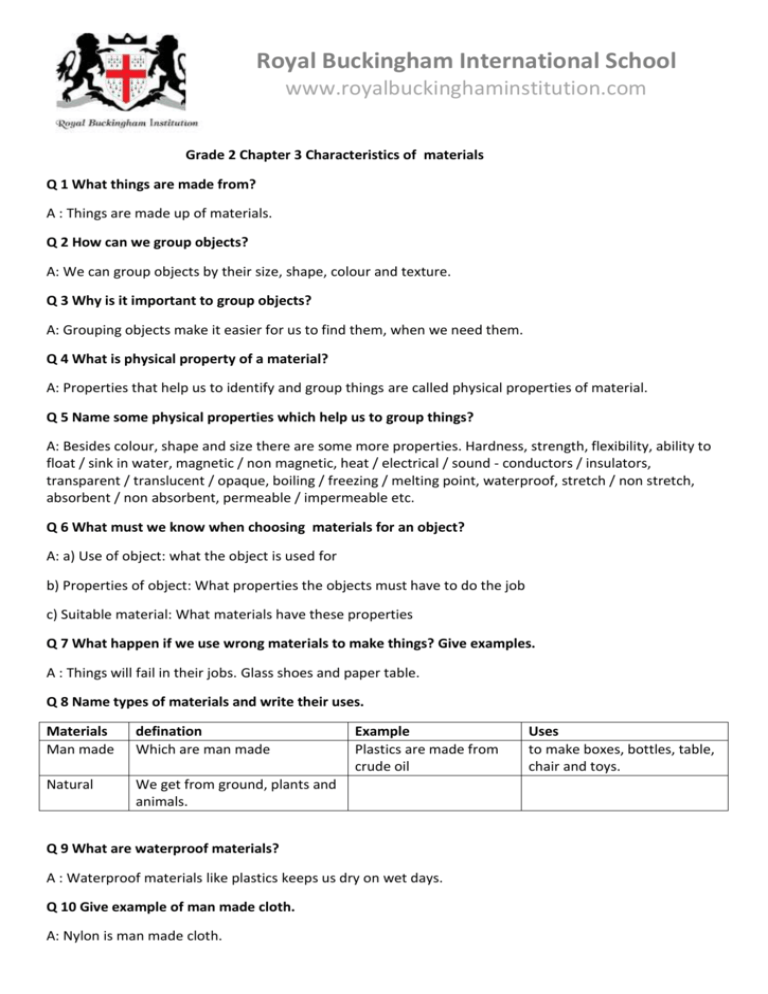
Royal Buckingham International School www.royalbuckinghaminstitution.com Grade 2 Chapter 3 Characteristics of materials Q 1 What things are made from? A : Things are made up of materials. Q 2 How can we group objects? A: We can group objects by their size, shape, colour and texture. Q 3 Why is it important to group objects? A: Grouping objects make it easier for us to find them, when we need them. Q 4 What is physical property of a material? A: Properties that help us to identify and group things are called physical properties of material. Q 5 Name some physical properties which help us to group things? A: Besides colour, shape and size there are some more properties. Hardness, strength, flexibility, ability to float / sink in water, magnetic / non magnetic, heat / electrical / sound - conductors / insulators, transparent / translucent / opaque, boiling / freezing / melting point, waterproof, stretch / non stretch, absorbent / non absorbent, permeable / impermeable etc. Q 6 What must we know when choosing materials for an object? A: a) Use of object: what the object is used for b) Properties of object: What properties the objects must have to do the job c) Suitable material: What materials have these properties Q 7 What happen if we use wrong materials to make things? Give examples. A : Things will fail in their jobs. Glass shoes and paper table. Q 8 Name types of materials and write their uses. Materials Man made defination Which are man made Natural We get from ground, plants and animals. Example Plastics are made from crude oil Q 9 What are waterproof materials? A : Waterproof materials like plastics keeps us dry on wet days. Q 10 Give example of man made cloth. A: Nylon is man made cloth. Uses to make boxes, bottles, table, chair and toys. Q 11 Give examples of materials that we get from ground write their uses. Material Metal Clay Glass Rocks Uses to make tools and utensils. to make pots, cups, plates and tiles. to make window panes, lenses, bottles and glasses. to make houses and roads. Q 12 Give examples of materials that we get from plants and write their uses. Material Wood Uses to make paper and furniture. Sources Trees Cotton Rubber To make clothes to make tyres, ballons ,erasers and toys. Cotton plant Rubber plant Q 13 Give examples of materials that we get from animals and write their uses. Material Leather Wool Silk Source Animal’s skin sheep Silk moth Uses to make belts, clothes, bags and shoes To make woollen clothes To make silk clothes Q 14 Make a table to show different physical propetries with examples. Property Hardness Definition Ability to withstand scratches Strenght (strong) Flextbility Ability to support heavy loads without breaking or tearing Ability to bend easily without breaking and to return to its original position Property Transparent Translucent Opaque Example Glass can scratch wood and plastic Steel is used to make bridges Opposite Softness Fishing rod can pull out a big fish out of water without breaking Non flexible Definition Materials that allow light to pass through them Materials that allow little light to pass through them Materials that do not allow light to pass through them Property Heat conductors Heat insulators Definition Materials that allow heat to pass through them Weak Example Clear glass, plastic, water Frosted glass,tracing paper Wood, metal Example Metals are used to make cooking utensils Materials that do not allow heat to pass through handles of cooking utensils are them made from plastic / wood. Property Electical conductors Electrical insulators Definition Materials that allow electricity to pass through them Materials that do not allow electricity to pass through them Property Sound conductors Definition Materials that allow sound to pass through them Sound insulators Materials that do not allow sound to pass through them Example Metals are used to make electrical cables Platics are used to cover electrical cables, switches and plugs Example Fire engine, ambulence, siren, alarm clock Carpets, double gazed windows, heavy curtains Property Magnetic Non magnetic Definition Materials which are attracted by magnet Materials which are not attracted by magnet Example Iron, steel, nickle and cobalt Wood, plastic, rubber and cloth Property Sink in water Float in water Definition Materials which fall to the bottom of the water Materials which stay on top of the water Example An anchor sinks in water A ship floats in water Property Absorbent Non absorbent Property Boiling point Melting point Freezing point Definition Which materials absorb water Which materials do not absorb water Definition Temperature at which a liquid changes to a gas Temperature at which a solid changes to a liquid Temperature at which a liquid changes to a solid Example Sponge, towel and paper towel Glass, plastic and rubber Example Pure water boils at 100 degree C Ice melts at 0 degree C Pure water freezes at 0 degree C ( The freezing and melting point of an objects are same. ) Q 15 Complete the chart given below. Choose any object and tell why and what material you will choose for that object. One example has been given. Name of object Boots Use of object To wear Properties of object Soft, flexible, fairly strong Suitable material Plastic, rubber Q 16 Tick the physical properties of the materials in the given box. Material/ properties Hard Soft Strong Weak Flexible Non flexible Sink in water Float in water Heat conductor Heat insulator Electrical conductor Electrical insulator Magnetic Non magnetic Transparent Translucent Opaque Permeable Non permeable Absorbent Non absorbent Stretchable Non stretchable Plastic Rubber Glass Clay Metal Cotton Leather Wood Grade 1 Chapter 3 Sorting and using materials Fill in the blanks with suitable answer. 1. Things are made up of ________________. 2 ___________ is used to make paper and furniture. 3 __________ is used to make tyres, ballons ,erasers and toys. 4 ___________ are used to make tools and utensils. 5 ___________are used to make boxes, bottles, table, chair and toys. 6 ___________ is used to make pots, cups, plates and tiles. 7 ____________ is used to make shoes, clothes, belts and bags. 8 ___________________materials keeps us dry on wet days. 9 Things fail in their jobs, if we use _______materials to make things. 10 There are ___________ types of materials. True or false 1. 2. 3. 4. 5. 6. 7. 8. 9. 10 Things are not made up of materials. Wood, metal , plastic, rubber, glass and clay are materials. Wood is used to make tyres, ballons ,erasers and toys. Metals are used to make tools and utensils. Plastics are used to make boxes, bottles, table, chair and toys. Leather is used to make pots, cups, plates and tiles. Metals are used to make shoes, clothes, belts and bags. Wood is used to make paper and furniture. Waterproof materials keeps us dry on wet days. Things will do their jobs if we use wrong materials to make things. Match the following by putting correct number in the given box. 1 Wood Shoes 2 Metal Waterproof 3 Things Pots and tiles 4 Plastics Waterproof 5 Rubber Toys 6 Clay Tools and utensils 7 Leather 8 Umbrella Tyres Paper Here are given some names of objects.Put them in the right material box . You can use one worn more than one time. clothes, belts, paper, furniture, tyres, ballons , utensils, boxes, erasers, toys, tools, bottles, table, chair, toys, plates and tiles, shoes, umbrella, rain coat, pots, cups, Vase, mirror and bags. Wood Metal Plastic Rubber Glass Leather Waterproof Clay


